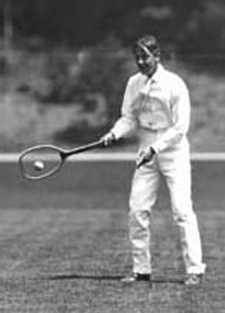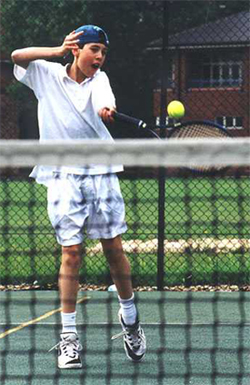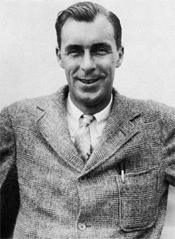Attack and Defense
William T. Tilden II
A chain is as strong as its weakest link--and no stronger. In these days of modern tennis a player is as strong as his weakest stroke. The old days of the one-stroke player, the lop-sided game, are gone forever. Today to reach the top a player must have everything. Therefore I turn to the vital question of the use of strokes.
Many a great match is won because the victor used the right stroke at the right time; and, conversely, many a championship has been lost by the player who picked the wrong stroke in the pinch. The most beautiful stroke, from a technical standpoint, is useless if it is hit to the wrong place at the wrong time, while often a sloppy-looking shot, to the right place in the court at the critical period, has swung defeat to victory.
One could cite hundreds of cases where one shot in the pinch won or lost a match, but the point which I am about to take up is not merely the one shot at the key psychological moment, but the question of the correct shots to play throughout a match.
I have heard some players claim that attack, and attack alone, is the objective at which to aim. Others say a sound defense is all one needs. It is just as ridiculous as arguing about whether a perfect baseliner can defeat the perfect volleyer. There are no such "animals." If there were, the perfect baseliner would beat the perfect volleyer in six love games because, by the definition of either perfect style, the baseliner would pass the volleyer every point. You cannot volley the service, and therefore the perfect baseliner would have one drive, which would win before the perfect volleyer could volley.
There is no use arguing about the relative values of Attack and Defense. There is no attack without defense, and no defense will succeed without attack. Most players have the firm conviction that the only way to meet an attack is by a counter offensive so severe that the attack breaks down; or that a defense can be shattered only by wearing the defending player down by greater steadiness. This is an absolutely wrong conception of tactics.
Let me once more quote the two most useful of all tennis mottoes:
"Never allow a player to play the game he prefers if you can possibly force him to play any other."
"Never give a player a shot he likes to play."
Obviously, by playing a man at his own game you are giving him shots he likes to play and which, in nine cases out of ten, he can play better than you. Meet defense with attack, and the attack with combined attack and defense. Note that I include attack in both cases, for only by attack can the winning punch be put across.
 |
It takes more than a wallop to dispose of Old Jo. |
Let me take the method of playing against that bane of all tennis players, the goat getter par
excellence, the Pat Ball Artist--in other words, Old Jo Gettem, who never misses anything. The familiar species
of genus homo, who thrives and abounds at all tennis clubs, is the fellow who scrambles all over the court
and pushes, shoves, pokes and pats back shots until you want to murder him. This is the man who annually
supplies about three-fourths of the upsets that enliven the tennis world. He is a particularly deadly enemy
to young players who have more strokes than brains and experience.
Believe me it requires more than a wallop to beat Old Jo Gettem. Certain very essential facts must be borne in mind by the player who is spending the afternoon playing old Jo in a match, if the player is to have any chance of victory. First, you cannot go out and just hit old Jo off the court, because you cannot win enough hitting everything to make up for your errors. Second, you cannot try to out steady Jo too long, because you will miss before he does, unless you can hit severely enough to force him to error.
Third, you cannot kill every shot old Jo hits to you because his strokes are so soft and cleverly placed that few of them give you a real chance to hit them hard. The only way to hit successfully against Jo Gettem is to wait your opportunity--and when it comes seize it. Therefore in playing old Jo Gettem you must be patient, steady until an opening comes, and then severe. In other words, you meet defense with defense until you find an opening that insures success in attack.
What is an opening against this defense? Old Jo will give you several of them, some of which may
pass unnoticed unless you are on the lookout for them. There are the more obvious openings of driving Jo 'way out
of court, to one side, and hitting hard to the other; and the shot which pulls him to the net so you can pass him,
for old Jo Gettem is seldom a good volleyer.
But one often misses other openings against Jo because on the face of things they do not appear to be openings. Every once in a few shots old Jo loses his depth hits to your midcourt. This is an opening and should be seized at once. Drive deep to one corner or the other of the court and advance to the net behind your shot. Once there, play to kill at once.
There is an opening with service, not one to use every time, because old Jo will learn it quickly, but one to use at discretion. Serve wide and come to the net unexpectedly. It will often break up old Jo, because it hurries him. In that little point lies the secret of playing old Jo Gettem and all his tribe. Hurry him! Whenever, wherever, and however possible, hurry the Pat-Ball Artist and you will find he is easy to beat, for he can not make his shots if he is hurried.
 |
Young Pete has a dangerous swat but knows little tennis. |
Old Jo Gettem has a first cousin, young Pete Swattem. Young Pete is the local hopeful at tennis clubs, "who will someday certainly be a Davis Cup star." You cannot miss him. He is usually tall, wiry, and very peppy. Often he has held the captaincy of the High School team in the past or won the singles championship of Smackemville. Actually he is far from dangerous at the given moment, but strange to say, the valuation of him as a future Davis Cup star may not be far from correct if young Pete Swattem learns tennis sense. Young Pete Swattcm is a far better tennis player potentially than old Jo Gettem, yet old Jo will smear young Pete regularly.
Once in a while young Pete hits a streak when all his swats are going in, and he beats a really good player.
The reason young Pete only does this on his good day is because he does not know enough tennis to use his strokes correctly
on the days when his swat is not going in.
There are many young Pete Swattems among the near great of the tennis world. I passed through a five-year period
as a leading member of the young "Pete Swattems" and recognize it, with regret, in others. Young Pete wallops every shot.
service, drive, volley and smash sail off his racquet, singing. Usually the backstop persuades the ball to stop, if it is
not the net that succeeds in doing so first.
Yet for all this young Pete is dangerous, because if his shots go in they are winners very often. Therefore,
in playing young Pete you should rely largely on defense, allowing him to pile up the errors off the backstop or in the net.
Only if he hits a streak and his shots are going in court consistently should you attack, and then only long enough to upset
his game. Young Pete Swattem thrives not upon returning the ball. He seems to join Lady Macbeth in her famous soliloquy,
"Out, damned Spot! Out I say!"




